IASbaba's Daily Current Affairs Analysis
Archives
(PRELIMS & MAINS Focus)
Syllabus
- Prelims – Art and Culture
Context: The Geographical Indications Registry has received an application from the Tribal Development Council, Andaman & Nicobar Islands, seeking the Geographical Indication (GI) tag for the Nicobari Hodi craft. This is the first application from the Union Territory seeking a tag for one of its products.
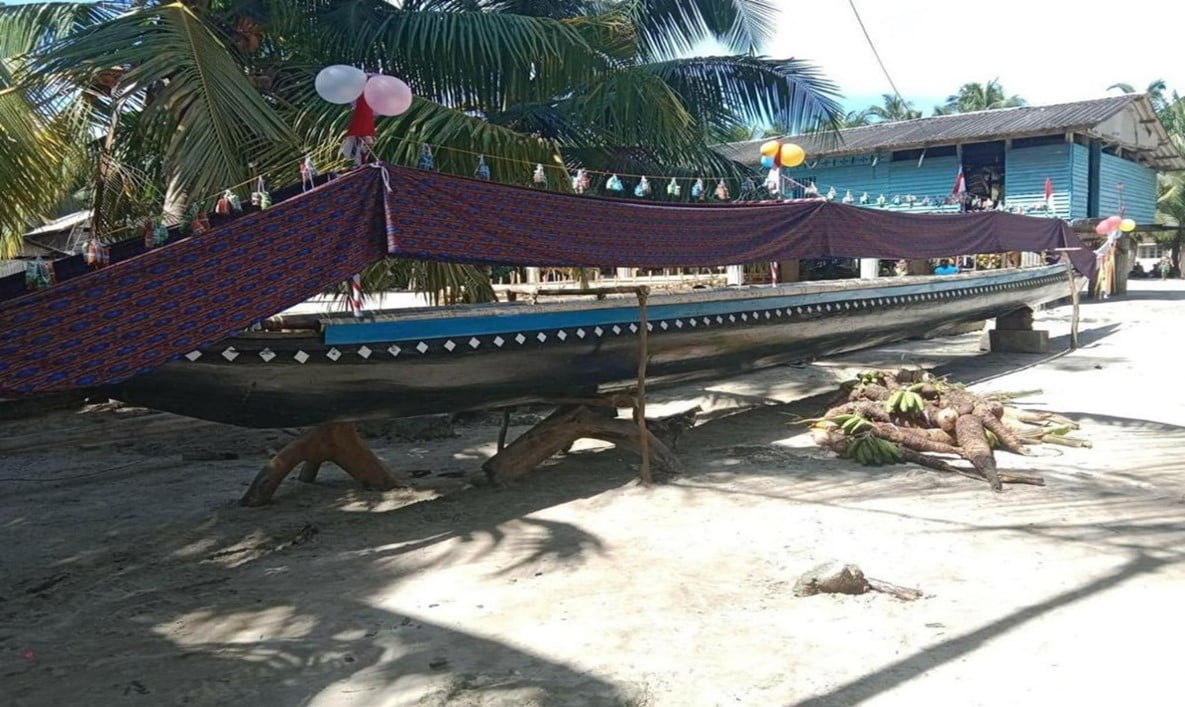
About Nicobari Hodi Craft:
- The hodi is the Nicobari tribe’s traditional craft.
- It is an outrigger canoe, very commonly operated in the Nicobar group of islands.
- The technical skills for building a hodi are based on indigenous knowledge inherited by the Nicobarese from their forefathers.
- The hodi is built using either locally available trees or from nearby islands, and its design varies slightly from island to island.
- The tuhet, a group of families under a headman, consider the hodi an asset. Hodi races are held between islands and villages.
Source: The Hindu
Previous Year Question
Q.1) With reference to India, the terms ‘Halbi, Ho and Kui’ pertain to (2022)
- dance forms of Northwest India
- musical instruments
- pre-historic cave paintings
- tribal languages
Syllabus
- Prelims – Environment and Ecology
Context: Unveiling yet another mystery of avian migrations, a great knot from Russia, belonging to the endangered Calidris tenuirostris (Horsfield, 1821), has found its way to Kerala’s coast, flying over 9,000 km for a winter sojourn.
About Great Knot:
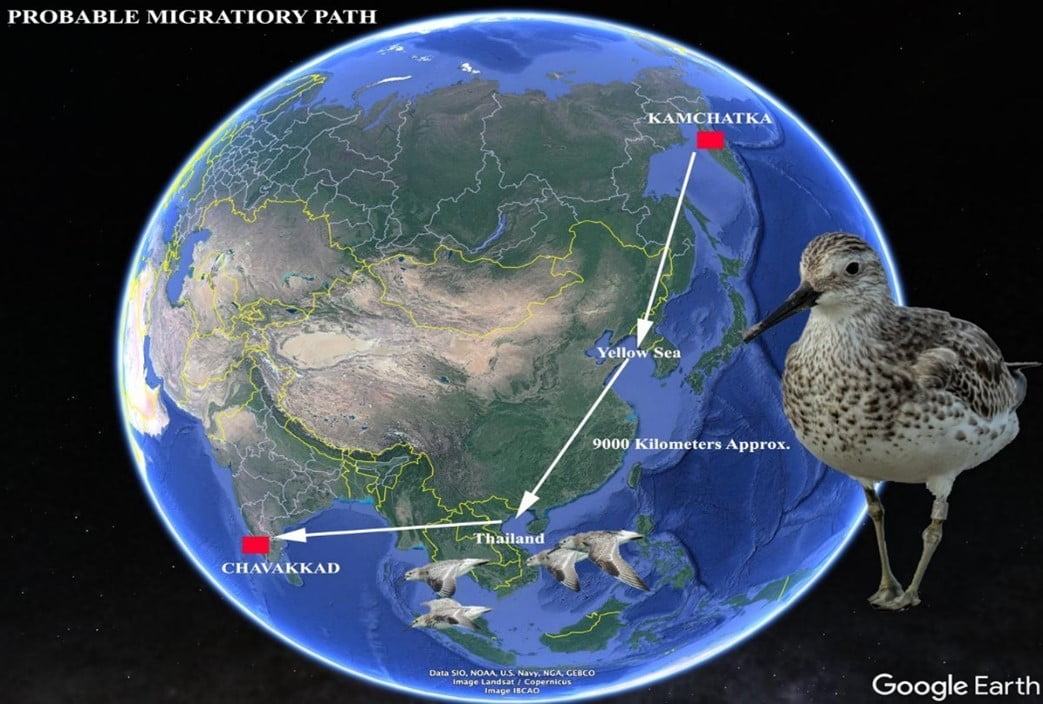
- It is a small wader.
- It is the largest of the Calidris species
- It is listed as an ‘endangered’ species by the IUCN.
- It is listed in Appendix I of the Convention on the Conservation of Migratory Species of Wild Animals.
- Habitat: Grassland, Marine Neritic, Marine Intertidal, Marine Coastal/Supratidal.
- This species breeds in northeast Siberia, Russia, wintering mainly in Australia, but also throughout the coastline of South-East Asia and on the coasts of India, Bangladesh, Pakistan, and the eastern coast of the Arabian Peninsula.
- Threats: Loss of intertidal stopover habitats in the Yellow Sea region is thought to be a key driver in the population declines of shorebirds
- It is also potentially threatened by climate change.
- Recent evidence shows a very rapid population decline caused by the reclamation of non-breeding stopover grounds, and under the assumption that further proposed reclamation projects will cause additional declines in the future.
Source: The Hindu
Previous Year Questions
Q.1) Which of the following is not a bird?
- Golden Mahseer
- Indian Nightjar
- Spoonbill
- White Ibis
Q.2) Which one of the following is a filter feeder?
- Catfish
- Octopus
- Oyster
- Pelican
Syllabus
- Prelims – Governance
Context: India is the only country to have received the Leadership in Family Planning (EXCELL) Awards-2022 in the ‘country category’ at the International Conference on Family Planning (ICFP).
About EXCELL Awards:
- The EXCELL Awards have been bestowed by the ICFP since the inception of the conference in 2009, as a way to publicly recognize extraordinary individuals, organizations and countries who have made significant contributions to the family planning field, and whose work deserves to be highlighted and used to inspire meaningful dialogue within the community.
- The ICFP has served as a strategic inflection point for the global reproductive health community, providing a global stage for more than 120 countries worldwide, organisations, and individuals to make important commitments and celebrate achievements as the world’s largest scientific conclave on family planning and reproductive health.
- The award is a recognition of India’s efforts towards ensuring access to quality family planning choices based on right information & reliable services.
- India has made outstanding progress not only in improving access but also adoption of modern contraceptive methods enabling couples to make informed choices about family planning.
Source: PIB
Syllabus
- Prelims – Current Affairs
In news: The 14th Dalai Lama conferred the Gandhi Mandela Award 2022 at Thekchen Choeling in Dharamshala’s McleodGanj.
- The Tibetan spiritual leader, said the qualities of non-violence and compassion had been ingrained in Indian culture for thousands of years.
- Dalai Lama is a “universal ambassador of peace”.
About the award:
- Gandhi Mandela Foundation instituted the award on the 150th birth anniversary of the Father of the Nation, MK Gandhi in 2019.
- New Delhi-based Gandhi Mandela Foundation is a non-profit organisation and a government of India registered Trust.
- It is formed with the motive to promote Mahatma Gandhi’s and former President of South Africa Nelson Mandela’s values of non-violence.
- The award is given to personalities who have carried forward the legacies of Gandhi and Mandela by making significant contributions in the fields of Peace, Social Welfare, Culture, Environment, Education, Healthcare, Sports and Innovation.
- Process of selection: This time, the awardee, Dalai Lama, was selected by a jury including former Chief Justice of India, former Chief Justice of Nepal and former Chief Justice of Bangladesh.
- Eminent nominees 2019 included Prime Minister of Nepal Khadga Prasad Sharma Oli, first president of Bangladesh Late Sheikh Mujibur Rahman, first president of Sri Lanka late Don Stephen Senanayake, former deputy Prime Minister of India Lal Krishna Advani.
Miscellaneous:
- The Dalai Lama is the recipient of the 1989 Nobel Peace Prize.
Source: Indian Express
Syllabus
- Prelims – Current Affairs
In News: Union Minister of Housing and Urban Affairs (MoHUA) launched Toilets 2.0 campaign at Bengaluru on World Toilet Day 2022.
- India is set to go beyond the Open Defecation Free (ODF) narrative.
About the campaign:
- Aims to change the face of public and community toilets in urban India through collective action involving citizens and Urban Local Bodies.
- The campaign has five thematic areas —
- ‘People for Toilets’
- ‘Partners for Toilets’
- A design challenge under the ‘Design Toilets’ theme
- ‘Rate your Toilet’
- ‘My thoughts – Our Toilets’
- The People for Toilets program is an inter-city competition envisaged for cleaning and maintaining community and public toilets in which top-performing cities will be recognised.
- The Partners for Toilets theme is to forge partnerships with potential organisations for the adoption of community and public toilets for interim cleaning, annual operations and maintenance, one-time financial aid, beautification activities, innovation, and feedback among others.
- The Design Challenge is being organised in collaboration with the Council of Architecture through which entries will be invited from students of architecture and practising architects on designs for aspirational toilets in the two categories of Public toilets and Community toilets. The top designs will be turned into a compendium for cities’ consideration to adopt for their facilities.
- Rate your Toilet is for promoting user feedback to improve public and community toilets
- My thoughts – Our Toilets is a general public survey among citizens on public toilets across the country. A questionnaire on citizen aspiration for toilets will be available on MyGov platform for the public to answer. The results from the survey are expected to help States and cities to understand gaps and provide course corrective measures.
- IA Champion of Change certificate will be rewarded to the participants at the end of the survey.
Significance:
- The campaign will energise and bring States, cities and citizens together to take forward a rich sanitation legacy under the Swachh Bharat Mission that will script the Toilets 2.0 journey of India.
- Clean and safe public restrooms and public spaces will improve the experience and quality of public life.
Source: The Hindu
Previous Year Question
Q1.) What is the aim of the programme ‘Unnat Bharat Abhiyan’? (2017)
- Achieving 100% literacy by promoting collaboration between voluntary organizations and government’s education system and local communities.
- Connecting institutions of higher education with local communities to address development challenges through appropriate technologies.
- Strengthening India’s scientific research institutions in order to make India a scientific and technological power.
- Developing human capital by allocating special funds for health care and education of rural and urban poor, and organizing skill development programmes and vocational training for them.
Syllabus
- Prelims – Polity
In News: An Indian Council of Historical Research (ICHR) concept note on Constitution Day has been criticised as an attempt to negate the country’s challenge of “caste-based social hierarchy”
- The themes chosen by the UGC for the Constitution Day lectures range from “Harappans: the pioneering architects of the democratic system in the world” to “Ancient Indian value system and concept of Kingship” and “Khap Panchayats and Democratic Traditions in Haryana”.
About the note:
- The note, circulated among Union ministries, underlines that the ancient democratic traditions explain the “survival of the Hindu culture and the civilisation in the face of the 2,000 years of invasions by alien ethnicities and cultures”.
- Recent archaeological excavations at Rakhigarhi and Sanauli reveal that the roots of people’s self-governance date back to at least 5,000 BCE.
- India has been practising democratic traditions since the “Vedic times” when villages developed a hierarchy of self-governing institutions such as panchayats and khaps
- Whether the existence of two kinds of states janapada and rajya or the two assemblies called sabha and samiti forming essential features of the government – all indicate that the ancient form of governance in India was democratic, contrary to the general belief that it was monarchical.
- In India, there was no concentration of the prestige of birth, influence of wealth and political office which made social organisations autocratic and aristocratic, like in Greece.
- The Hindu state rarely presented that high degree of centralisation associated with the Roman empire
- The survival of Hindu culture has become possible because the Hindu mind from the beginning addressed the central question of how to weld this vast multiplicity that is India into a single larger community and from ancient times a geo-cultural definition has been given to this entity, rashtra, Bharata.
Indian Council of Historical Research (ICHR):
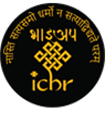
- It is an autonomous organization under the Ministry of Education, Government of India
- It was established in 1972.
- ICHR was registered under Societies Registration Act being an Act for registration of Literary, Scientific and Charitable Societies in India.
- The primary aim and objective is to promote and give directions to scientific research in history and to encourage and foster objective and scientific writing of history.
- Council advises the Government of India on all such matters pertaining to historical research and training in history methodology.
- It consists mainly of eminent historians of the country.
Source Indian Express
Syllabus
- Prelims – Environment
In News: The death toll from the earthquake in Indonesia has risen to 162 with hundreds injured and over 13,000 displaced.
About the disaster:
- The US Geological Survey said the magnitude 5.6 quake was centered in the Cianjur region in West Java province at a depth of 10 kilometres (6.2 miles).
- Indonesia’s Meteorology, Climatology, and Geophysical Agency recorded at least 25 aftershocks.
- Several landslides were reported around Cianjur.
- Indonesia, the country of more than 270 million people is frequently struck by earthquakes, volcanic eruptions and tsunamis because of its location on the “Ring of Fire,”
- It also caused panic in the greater Jakarta area, where high-rises swayed and some were evacuated. Earthquakes occur frequently across the sprawling archipelago nation, but it is uncommon for them to be felt in Jakarta.
- Other earthquakes in Indonesia:
- In February 2022, a magnitude 6.2 earthquake killed at least 25 people and injured more than 460 in West Sumatra
- In January 2021, a magnitude 6.2 earthquake killed more than 100 people and injured nearly 6,500 in West Sulawesi
About Ring of Fire:
- The Ring of Fire, also referred to as the Circum-Pacific Belt, is a path along the Pacific Ocean characterized by active volcanoes and frequent earthquakes.
- It is a horseshoe-shaped belt about 40,000km long and about 500 km wide that contains two-thirds of the world’s total volcanoes and 90% of Earth’s earthquakes.
- It traces boundaries between several tectonic plates—including the Pacific, Juan de Fuca, Cocos, Indian-Australian, Nazca, North American, and Philippine Plates.
- The Ring of Fire is a direct result of plate tectonics:
- Along much of the Ring of Fire, plates overlap at convergent boundaries called subduction zones. That is, the plate that is underneath is pushed down, or subducted, by the plate above. As rock is subducted, it melts and becomes magma. The abundance of magma so near to Earth’s surface gives rise to conditions ripe for volcanic activity.
- Transform boundary: The border between the Pacific and North American Plates is a transform boundary, where plates move sideways past one another and generates many earthquakes as tension in Earth’s crust builds up and is released.
- Consumption of oceanic lithosphere at these convergent plate boundaries has formed oceanic trenches, volcanic arcs, back-arc basins, and volcanic belts.
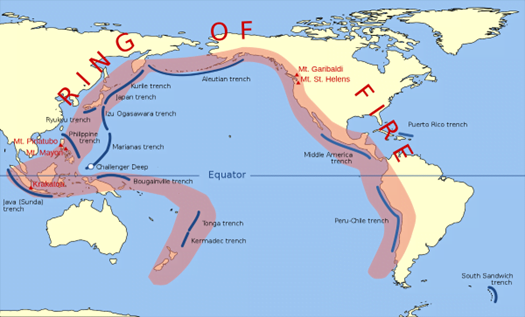
Source: Indian Express
Previous Year Question
Q.1) Consider the following statements: (2018)
- The Barren Island volcano is an active volcano located in the Indian territory.
- Barren Island lies about 140 km east of Great Nicobar.
- The last time the Barren Island volcano erupted was in 1991 and it has remained inactive since then.
Which of the statements given above is/are correct?
- 1 only
- 2 and 3
- 3 only
- 1 and 3
Syllabus
- Mains – GS 3 (Environment)
Context: Recently India submitted its Long-Term Low Emission Development Strategy to the United Nations Framework Convention on Climate Change (UNFCCC) at the 27th Conference of Parties (COP27) which was held in Sharm-el-Sheikh, Egypt.
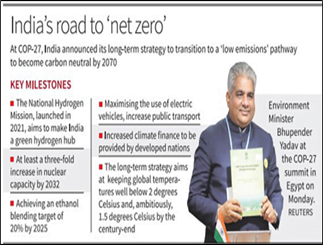
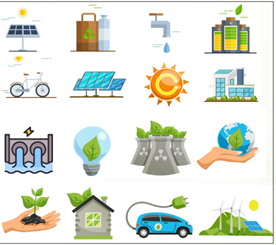
About 27th Conference of Parties (CoP27):
- Conference of Parties(COP) is the supreme decision-making body of the UNFCCC.
- The agreement seeks to limit global warming to well below 2°C, preferably to 1.5°C, compared to pre-industry levels.
- COP27 was labelled as an “implementation” conference, in the sense that countries were determined to solve outstanding questions on climate finance.
- This refers to money that developed countries had committed to developing countries to help them turn their economies away from fossil fuels, build resilient infrastructure to climate shocks and access technologies to enable widespread use of renewable energy.
About Long-Term Low Emissions Development Strategy:
- The 2015 Paris Agreement requires all parties to create a long-term low greenhouse gas emissions development strategies (LT-LEDS) based on their various responsibilities and capabilities as per the different national-level circumstances.
- The COP26, held in Glasgow in November 2021, required the parties who have not yet communicated their LT-LEDS to submit them by COP27.
- India’s LT-LEDS was prepared after extensive consultations with various government entities, state governments, research institutes and civil society organizations.
Key Pillars of the India’s strategy: The 7 key pillars of the strategy are
- Low-carbon electricity systems consistent with development
- Integrated, efficient and inclusive low-carbon transport systems,
- Energy and material-efficiency in buildings,
- Decoupling growth from emissions and developing an efficient, low-emission industrial system,
- CO2 removal and related engineering solutions,
- Enhancing forest cover consistent with socioeconomic and ecological considerations
- Increasing climate resilience in poverty eradication and employment creation.
Salient features of India’s (LT-LEDS):
- Forest Cover: India has a strong record of enhancing forest and tree cover in the last three decades alongside high economic growth.
- India’s forest fire incidence is well below global levels, while its forest and tree cover are a net sink absorbing 15% of CO2 emissions in 2016.
- India is on track to fulfilling its NDC commitment of 2.5 to 3 billion tonnes of additional carbon sequestration in forest and tree cover by 2030.
- Transition from fossil fuels: The transition from fossil fuels will be undertaken in a just, smooth, sustainable and all-inclusive manner.
- Transportation sector: Increased use of biofuels, especially ethanol blending in petrol, the drive to increase electric vehicle penetration and the increased use of green hydrogen fuel is expected to drive the low carbon development of the transport sector.
- Sustainable Urbanization: Future sustainable and climate-resilient urban development will be driven by smart city initiatives, integrated planning of cities, effective green building codes and rapid developments in innovative solid and liquid waste management.
- Industrial Sector: India’s industrial sector will continue on a strong growth path in the perspective of ‘Atma Nirbhar Bharat’ and ‘Make in India’.
- The focus will be on improving energy efficiency by initiatives such as Perform, Achieve and Trade (PAT) scheme, high levels of electrification, enhancing material efficiency and recycling leading to the expansion of the circular economy.
- Transition to low-carbon development: The transition to the low carbon development pathway will entail several costs pertaining to the development of new technologies, new infrastructure, and other transaction costs.
- The provision of climate finance by developed countries will play a very significant role in this.
India’s NDCs:
- The NDCs, which India must periodically update, are voluntary commitments by countries to reduce emissions by a fixed number relative to a date in the past to achieve the long-term goal of climate agreements of preventing global temperature rising beyond 1.5°C or 2°C by the end of the century.
- Thus, India’s most updated NDC commits to ensuring that half its electricity is derived from non-fossil fuel sources by 2030 and reducing the emissions intensity by 45% below 2005 levels by 2030.
- They are concrete targets unlike the low-carbon strategy which is qualitative and describes a pathway.
Issues associated with climate resilient strategies:
- Funding: Of nearly $100 billion annually committed in 2009, which was to have been arranged for by 2020, less than a third has come in.
- Much of this, and this has been pointed out by several countries including India, is in the form of loans or come with conditions that increase the economic burden on developing countries.
- Clear delivery: There is a demand that developed countries must come up with a new target, described in negotiations as a New Collective Quantified Goal, with a clear path of delivery and a higher amount, to the tune of “trillions of dollars” to account for increased costs of energy transition.
- Loss and Damage: This is a proposal to compensate the most vulnerable countries and developing countries who are facing the brunt of climate change for the damage that has already incurred.
- The European Union was resistant to announcing a fund this year, on the grounds that it would take years to materialise and there were other options to get money flowing where it was most needed.
- Action plans falling short: It’s been at least two-and-a-half decades since the world decided to restrain its greenhouse gas emissions.
- Latest assessments suggest that current action plans of countries to meet climate goals are falling woefully short.
- Rising emissions: In absolute terms, the annual global emissions are still rising, now touching almost 50 billion tonnes of carbon dioxide equivalent.
- In the decade between 2010 and 2019, the global emissions grew by over one percent on average.
- This is significantly slower than the growth in the previous decade, of about 2.6 percent, but for meeting climate targets, it is not good enough.
- Ukraine war: The energy and economic crisis caused by the Ukraine war is threatening to undo even the small gains made.
- Inadequate & unfair response: The response in terms of emission cuts has been inadequate.
- The rich and industrialised countries:
- These were the main polluters and hence mainly responsible to bring down emissions, have not met their collective targets.
- Developing countries: Countries like China or India, which were not major emitters till sometime back, have seen their emissions rise steeply.
Global picture
- EU: As a bloc, the European Union has done relatively better on climate goals, with the United Kingdom, which is struggling with an economic downturn right now, halving its emissions from 1990 levels, UN data shows.
- USA: The United States, the world’s leading emitter until it was overtaken by China in the mid-2000s, has been a major laggard, cutting its emissions by only about 7 percent from 1990 levels.
- India & China: China’s emissions have risen by almost four times, and India’s by about three times, during this period.
Way Forward:
- Climate change is a global problem and it requires cooperation between all nations along with adopting rules that are fair and just, for the poor and the rich alike.
- Science is clear that humans are responsible for the global temperature rise and that this increase will lead to more and more variable and extreme weather events, much like what we are seeing now.
- it is possible to estimate each country’s responsibility for the stock of emissions already in the atmosphere — the historical cumulative emissions that have “forced” climate change impacts.
- Countries that have not yet contributed to the emissions will do so in the future, simply because the world has reneged on the need to make global rules that would apply fairly to all.
For a realistic chance to keep global warming within 1.5 degree Celsius, annual emissions would need to drop from the current level of about 50 billion tonnes of CO2 equivalent to about 33 billion tonnes by 2030 and 8 billion tonnes by 2050, according to the newest Emissions Gap Report. Even for meet the 2-degree target, emissions have to come down to about 41 billion tonnes by 2030 and 20 billion tonnes by 2050.This would require drastic action from all the major emitters.
Source: PIB
Previous Year Question
Q.1) In the context of India’s preparation for Climate-smart Agriculture, consider the following statements:
- The ‘Climate-Smart village’ approach in India is a part of a project led by climate change, Agriculture and food security (CCAFS), an international research programme.
- The project of CCAFS is carried out under Consultative Group on International Agricultural Research (CGIAR) headquartered in France.
- The International Crops Research Institute for the Semi-Arid Tropics (ICRISAT) in India is one of the CGIAR’S research centres.
Which of the statements given above are correct? (2021)
- 1 and 2 only
- 2 and 3 only
- 1 and 3 only
- 1,2 and 3
Syllabus
- Mains – GS 2 (Governance)
Context: Recently, the Govt has extended the Pradhan Mantri Garib Kalyan Anna Yojana (PMGKAY), a scheme to distribute free foodgrains to the poor, for another three months (October 2022-December 2022).
About Pradhan Mantri Garib Kalyan Anna Yojana (PMGKAY):
- It was started during the difficult time of COVID-19 crisis, to provide food security to the poor, needy and the vulnerable households/beneficiaries so that they do not suffer on account of non-availability of adequate foodgrains.
- It is a part of the Pradhan Mantri Garib Kalyan Package to help the poor fight battle against Covid-19.
- PMGKAY has so far had an estimated subsidy of Rs 3.45 lakh crore in six phases.
- Phase VII (Oct 2022- Dec 2022) of PMGKAY entails an estimated subsidy of Rs. 44,762 Crore.
- After considering the estimated outgo of foodgrains — about 122 lakh tonnes during the current phase of extension, the aggregate allocation will be around 1,121 lakh tonnes.
Features of PMGKAY:
- Under this welfare scheme, 5 kg of food grain per person per month is provided free of cost for all the beneficiaries covered under the National Food Security Act (NFSA) (Antodaya Anna Yojana & Priority Households) including those covered under Direct Benefit Transfer (DBT).
- This is over and above the regular monthly quota under the NFSA, i.e., 35 kg per month per family for AAY and 5 kg per month a person for PHH(Priority Household).
- There are around 80 crore beneficiaries who come under the National Food Security Act (NFSA).
Performance of PMGKAY:
- Policymakers and experts concede that the scheme made a difference to food security and public health during the pandemic.
- For instance, it has been commended by the Parliamentary Standing Committee on Food and Public Distribution and also by an IMF-published working paper, “Pandemic, Poverty, and Inequality: Evidence from India” (April 2022) which concluded that “the social safety net provided by the expansion of India’s food subsidy program absorbed a major part of the pandemic shock.”
Concern over the Extension:
- Promote Freebies Culture: This scheme promotes the culture of freebies and the significance of freebies culture is under debate.
- Financial Issues: There were reports in June that the Expenditure Department at the Centre did not favour it, citing a funds crunch.
- With the expenditure of ₹44,762 crores for the existing phase, the overall expenditure of the PMGKAY will be approximately ₹3.91 lakh crore.
- Relevance in Non-pandemic Time: It also held the view that such a scheme was no longer needed “in non-pandemic times”.
- Impact on Global Level: This has to be viewed in the context of the Russia-Ukraine conflict, raging since February 2022, and its adverse impact on the world’s food and energy sectors.
- Political Agenda: Critics of the ruling party point out that the scheme’s extension is with an eye on the Assembly elections in Himachal Pradesh and Gujarat, respectively.
Way Forward:
- The central authorities should commission a comprehensive and transparent study and make its findings public.
- The proposed study should be the basis for updating the database of foodgrain-drawing card holders, scrutinizing the data critically and zeroing in on the needy
- It would have been far better had the Government taken the decision to extend the scheme based on findings of an objective study regarding the impact of the PMGKAY, as suggested by the Standing Committee in its March 2022 report.
- The centre should consider providing 1 kg pulses free to States on a regular basis, or at least at highly subsidized rates.
The central and State authorities need to ponder over the scheme’s continuance, given the chronic problem of diversion from the Public Distribution System (PDS). To keep the budgetary allocation under control, rules on quotas for rice or wheat can be changed suitably.
Source: The Hindu
Syllabus
- Mains – GS 2 International Relations
In News: India has proposed a permanent secretariat for “No Money for Terror (NMFT),” a ministerial body, to sustain the continued global focus on countering the financing of terrorism.
- India will circulate a discussion paper to all participating jurisdictions for their valuable comments
Context:
- India is the chair of 3rd Ministerial No Money for Terror (NMFT) and reiterated India’s position that all countries will have to agree on one common definition of ‘terrorism’ and ‘terror financing’.
- No country or organisation can successfully combat terrorism, alone and the international community must continue to fight shoulder-to-shoulder against this increasingly complex and borderless threat.
- Hence, now the time is ripe for a permanent Secretariat to be established.
What is NMFT conference:
- It is a conference on counter-terrorism financing with representatives of 75 countries and global bodies.
- It aims to discuss key issues including use of dark web, virtual assets, crowdfunding platforms, Money Transfer Service Scheme and hawala networks by terrorist entities.
- It discusses the use of formal and informal channels of funding terrorism, emerging technologies and terrorist financing, and requisite international cooperation to address related challenges
- The declaration acknowledged the “essential” role of the Financial Action Task Force (FATF) –FATF is a multilateral body that monitors terror financing and money laundering and NMFT is complimentary to FATF as the latter is membership based while NMFT is ministerial.
Challenges of terrorism:
- Terror attacks: the blowing up of the Air India aircraft over the Irish Sea in 1985, the numerous attacks and massacres in Punjab and Kashmir in the 1990s, bombings in various cities, culminating into Mumbai attack of 2008, and so on.
- Radicalisation: Under the guise of other motives, some organisations promote terrorism and radicalisation at the national and international levels and tend to become the medium of financing terrorism.
- Recently, India banned Popular Front of India (PFI) under Unlawful Activities (Prevention) Act (UAPA) for its radical and exclusivist style of minority politics.
- Economic cost: As per IMF and the World Bank, criminals around the world launder around 2 to 4 trillion dollars every year and a major part of it goes to fuel terrorism.
- Lack of global unity: China’s constant blockage of listing names suggested by India (Sajid Mir of LeT) to be included in UNSC 1267 list of terrorists is a challenge to uniformity against terrorism since being on the ‘Grey List’ made it difficult for Pakistan to obtain loans from financial institutions like the IMF, World Bank and ADB.
- Technological leverage: the terrorist threat had morphed into using social media for recruitment and incitement, along with drones, VPNs, message encryption apps, blockchain and digital currencies. For instance, in 2022, security forces have noted 171 drone flights.
- Kashmir Insurgency: In Kashmir, terrorist forces are operating through The Resistance Front (TRF) and conducting highly effective attacks aimed at keeping the situation on the boil.
Suggestions for future:
- The Government of India has decided to develop national and global databases on crimes such as terrorism, narcotics, and economic offenses.
- The United Nations Security Council has developed a framework to deal with the threat of terrorism, with the main objective of creating a “counter-terrorism sanctions regime” which must be further strengthened, made more rigorous, and transparent.
- All countries and organisations must pledge complete transparency in sharing intelligence in a better and more effective manner including every geographical and virtual space.
- Expanding the concerns over terrorism beyond transnational groups such as the Islamic State (IS) and Al Qaeda, and flagging the existence of safe havens – two pet concerns of India.
- NMFT conference also calls for partnerships with the private sector, including financial institutions, financial technology industry and internet and social media companies, about the evolution of trends, sources and methods of the financing of terrorism.
- Measures may include preventing diversion from legal financial instruments by fighting anonymity in financial networks, restricting the use of proceeds of other crimes for terrorist activities, preventing use of new financial technologies, virtual assets such as crypto-currencies, wallets etc.
Way forward:
- Prevention of the use of Non-Profit Organisations (NPOs) to spread terror Ideology is crucial.
- There is a need to uphold the importance of a Whole-of-Government and Whole-of-Society approach, whereby cooperation in countering terrorism and its financing between all relevant stakeholders, including the Executive, the Legislature, the Judiciary, civil society, and private sector, is ensured.
Source The Hindu Business line
Daily Practice MCQs
Q.1) Consider the following statements:
- The Ring of Fire is a 50,000 km long fault line in Pacific Ocean.
- It contains two-thirds of world’s total volcanoes.
- It traces the boundary with Indian-Australian plate and African plate.
Which of the statements given above are correct?
- 1 and 2 only
- 3 only
- 2 only
- 2 and 3 only
Q.2) Consider the following in respect of ‘Toilets 2.0’:
- Toilets 2.0 is an initiative of the Ministry of Health and Family Welfare, Government of India.
- Toilets 2.0 has been launched in a mission mode to improve community toilets in rural areas through collective action.
- It has five thematic areas including a design challenge.
Select the correct answer using the code given below.
- 1 and 2 only
- 3 only
- 2 and 3 only
- 1, 2 and 3
Q.3) Consider the following statements regarding Pradhan Mantri Garib Kalyan Anna Yojana (PMGKAY):
- It was started during the difficult time of COVID-19 crisis, to provide food security to the poor, needy and the vulnerable households/beneficiaries.
- Under this welfare scheme, 15 kg of foodgrains per person per month is provided free of cost for all the citizens of India.
Which of the statements given above is/are correct?
- 1 only
- 2 only
- Both 1 and 2
- Neither 1 nor 2
Comment the answers to the above questions in the comment section below!!
ANSWERS FOR ’22nd November 2022 – Daily Practice MCQs’ will be updated along with tomorrow’s Daily Current Affairs.st
ANSWERS FOR 21st November – Daily Practice MCQs
Q.1) – c
Q.2) – d
Q.3) – b











